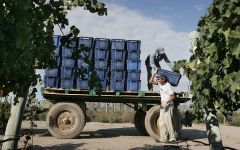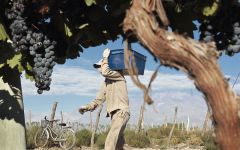Antucura Cabernet Sauvignon 2018
- Vinous



Product Details
Your Rating
Somm Note
Winemaker Notes
The idea of this wine was to create the perfect marriage between Argentina and France, between Bordeaux and the Uco Valley. The focus was to create a wine of balance, using the classical identifiers of great Cabernet, but infusing some regional charm. This Cabernet Sauvignon vineyard has rocky, stony soils which means that the vines struggle for moisture. This increases the concentration of their fruit by naturally reducing crop size, berry size and bunch size. They try not to remove leaves during the harvest to avoid direct sun exposure on the clusters. Vines are kept on "life support" throughout harvest season by their drip irrigation system, which allows them to perform high quality, precise viticulture. The typical Vista Flores Cabernet Sauvignon shows hints of spices and sometimes soft black pepper and fresh black fruits and red fruits. With an friendly, warm palate attack and firm, ripe tannins, it has tremendous juiciness and elegance in the mouth.
Professional Ratings
-
Vinous
A Cabernet Sauvignon from Vista Flores bottled in July 2019. Purple in the glass. The nose offers notes of herb, fennel, plum and black currant and a touch of tomato preserve. With firm tannins and a deep flavor, the feel is ripe but restrained by the year spent in the bottle. Will greatly improve over time.
Other Vintages
2015-
James
Suckling
- Decanter
-
Robert
Parker








For Anne-Caroline Biancheri, the idea of starting a family represented the decision to undertake a life conceived from the values, landscapes and aromas with which she wanted to see her children grow up. She started with land. Looking for such a place, she discovered Vista Flores, in the Uco Valley of Mendoza. This privileged area of incomparable beauty, framed by the Andes mountains, offers the best climatic and geographical conditions to create emblematic wines. There, Antucura began to take root in the land of the original inhabitants of the area. A place where stones embrace vines on its rich terroir. Antucura means “Sun Stone”, according to the local ancient language Mapudungun.

A noble variety bestowed with both power and concentration, Cabernet Sauvignon enjoys success all over the globe, its best examples showing potential to age beautifully for decades. Cabernet Sauvignon flourishes in Bordeaux's Medoc where it is often blended with Merlot and smaller amounts of some combination of Cabernet Franc, Malbecand Petit Verdot. In the Napa Valley, ‘Cab’ is responsible for some of the world’s most prestigious, age-worthy and sought-after “cult” wines. Somm Secret—DNA profiling in 1997 revealed that Cabernet Sauvignon was born from a spontaneous crossing of Cabernet Franc and Sauvignon Blanc in 17th century southwest France.

By far the largest and best-known winemaking province in Argentina, Mendoza is responsible for over 70% of the country’s enological output. Set in the eastern foothills of the Andes Mountains, the climate is dry and continental, presenting relatively few challenges for viticulturists during the growing season. Mendoza, divided into several distinctive sub-regions, including Luján de Cuyo and the Uco Valley, is the source of some of the country’s finest wines.
For many wine lovers, Mendoza is practically synonymous with Malbec. Originally a Bordelaise variety brought to Argentina by the French in the mid-1800s, here it found success and renown that it never knew in its homeland where a finicky climate gives mixed results. Cabernet Sauvignon, Syrah, Merlot and Pinot Noir are all widely planted here as well (and sometimes even blended with each other or Malbec). Mendoza's main white varieties include Chardonnay, Torrontés, Sauvignon Blanc and Sémillon.
